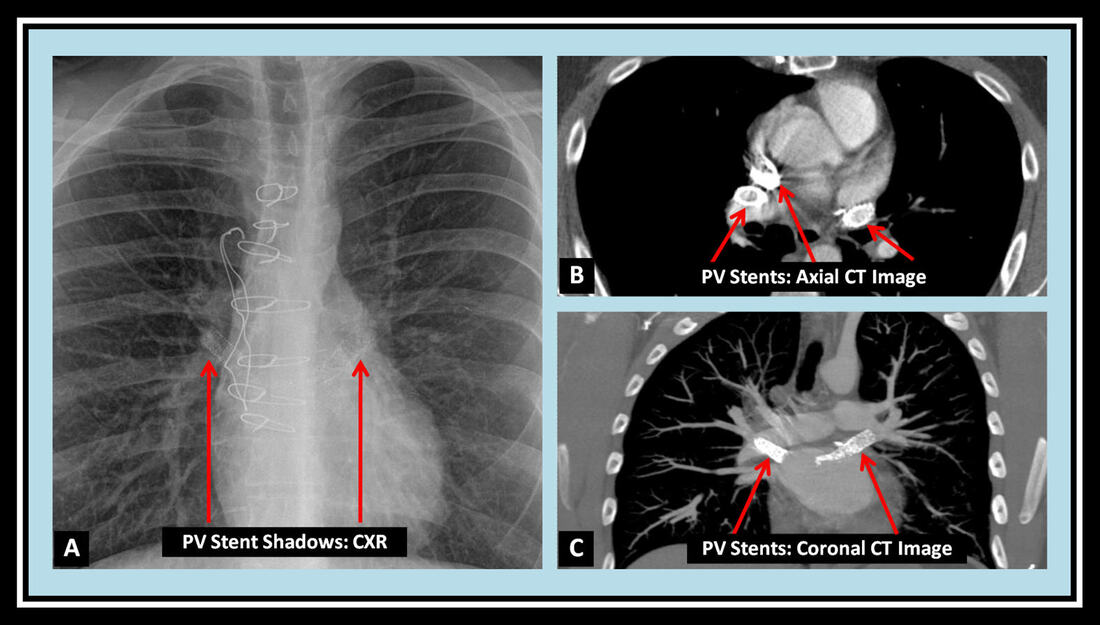August 2022 Issue
ISSN 2689-291X
ISSN 2689-291X
Pulmonary Vein Stenting:
Sequelae of Pulmonary Vein Isolation!
Description
The above images show chest radiograph (CXR) with shadows of large stents along the left atrial borders (A). Axial computed tomography (CT) image reveals three stents in the pulmonary veins (PV); two in the right pulmonary veins and one in the left pulmonary vein (B). Coronal CT image (C) demonstrates two of the three stents in the right and left pulmonary veins.
The stents were placed in the setting of symptomatic severe pulmonary vein stenosis following pulmonary vein isolation ablation for atrial fibrillation. Symptomatic improvement was documented following the procedure, with maintenance of sinus rhythm.
Discussion
Pulmonary vein stenosis results from tissue injury due to either thermal- or cryo-ablation of the pulmonary veins employed in the treatment of atrial fibrillation, with the earlier incidence of nearly 40% for ablation within the PV ostia now lower (~ 0.3% – 3%) with circumferential and antral ablation (1).
Symptoms of pulmonary vein stenosis are variable and often nonspecific, thereby delaying the diagnosis. Several diagnostic modalities have been employed including CT, magnetic resonance imaging (MRI), transesophageal echocardiography (TEE) pulmonary imaging and invasive angiography (2).
Management of pulmonary vein stenosis varies and can range from observation for isolated unilateral asymptomatic stenosis to interventional treatment with balloon angioplasty or stent placement (3). Earlier analyses reported a restenosis rate of 46%, higher following balloon angioplasty compared to stent placement (4). More recent analysis did not yield any significant difference between both approaches (5).
References
Authors:
Nikky Bardia, M.D.
Cardiology Fellow
University of South Alabama
Mobile, AL
Alexis Parks, D.O.
Internal Medicine Resident
University of South Alabama
Mobile, AL
Maulikkumar Patel, M.D.
Cardiology Fellow
University of South Alabama
Mobile, AL
Usman Sarwar, M.D.
Cardiology Fellow
University of South Alabama
Mobile, AL
Nupur Shah, M.D.
Cardiology Fellow
University of South Alabama
Mobile, AL
Rajasekhar Mulyala, M.D.
Cardiology Fellow
University of South Alabama
Mobile, AL
Mariam Riad, M.D.
Cardiology Fellow
University of South Alabama
Mobile, AL
Mustafeez Ur Rahman, M.D.
Cardiology Fellow
University of South Alabama
Mobile, AL
G. Mustafa Awan, M.D.
Professor of Cardiology
University of South Alabama
Mobile, AL
Christopher Malozzi, D.O.
Associate Professor of Cardiology
University of South Alabama
Mobile, AL
Bassam Omar, M.D., Ph.D.
Professor of Cardiology
University of South Alabama
Mobile, AL
The above images show chest radiograph (CXR) with shadows of large stents along the left atrial borders (A). Axial computed tomography (CT) image reveals three stents in the pulmonary veins (PV); two in the right pulmonary veins and one in the left pulmonary vein (B). Coronal CT image (C) demonstrates two of the three stents in the right and left pulmonary veins.
The stents were placed in the setting of symptomatic severe pulmonary vein stenosis following pulmonary vein isolation ablation for atrial fibrillation. Symptomatic improvement was documented following the procedure, with maintenance of sinus rhythm.
Discussion
Pulmonary vein stenosis results from tissue injury due to either thermal- or cryo-ablation of the pulmonary veins employed in the treatment of atrial fibrillation, with the earlier incidence of nearly 40% for ablation within the PV ostia now lower (~ 0.3% – 3%) with circumferential and antral ablation (1).
Symptoms of pulmonary vein stenosis are variable and often nonspecific, thereby delaying the diagnosis. Several diagnostic modalities have been employed including CT, magnetic resonance imaging (MRI), transesophageal echocardiography (TEE) pulmonary imaging and invasive angiography (2).
Management of pulmonary vein stenosis varies and can range from observation for isolated unilateral asymptomatic stenosis to interventional treatment with balloon angioplasty or stent placement (3). Earlier analyses reported a restenosis rate of 46%, higher following balloon angioplasty compared to stent placement (4). More recent analysis did not yield any significant difference between both approaches (5).
References
- Fender EA, Widmer RJ, Hodge DO, Cooper GM, Monahan KH, Peterson LA, Holmes DR Jr, Packer DL. Severe Pulmonary Vein Stenosis Resulting From Ablation for Atrial Fibrillation: Presentation, Management, and Clinical Outcomes. Circulation. 2016 Dec 6;134(23):1812-1821.
- Pürerfellner H, Martinek M. Pulmonary vein stenosis following catheter ablation of atrial fibrillation. Curr Opin Cardiol. 2005 Nov;20(6):484-90.
- Kumar N, Aksoy I, Pison L, Timmermans C, Maessen J, Crijns H. Management Of Pulmonary Vein Stenosis Following Catheter Ablation Of Atrial Fibrillation. J Atr Fibrillation. 2014 Jun 30;7(1):1060.
- Buiatti A, von Olshausen G, Martens E, Schinke K, Laugwitz KL, Hoppmann P, Ibrahim T. Balloon angioplasty versus stenting for pulmonary vein stenosis after pulmonary vein isolation for atrial fibrillation: A meta-analysis. Int J Cardiol. 2018 Mar 1;254:146-150.
- Fender EA, Widmer RJ, Mahowald MK, Hodge DO, Packer DL, Holmes DR Jr. Recurrent pulmonary vein stenosis after successful intervention: Prognosis and management of restenosis. Catheter Cardiovasc Interv. 2020 Apr 1;95(5):954-958.
Authors:
Nikky Bardia, M.D.
Cardiology Fellow
University of South Alabama
Mobile, AL
Alexis Parks, D.O.
Internal Medicine Resident
University of South Alabama
Mobile, AL
Maulikkumar Patel, M.D.
Cardiology Fellow
University of South Alabama
Mobile, AL
Usman Sarwar, M.D.
Cardiology Fellow
University of South Alabama
Mobile, AL
Nupur Shah, M.D.
Cardiology Fellow
University of South Alabama
Mobile, AL
Rajasekhar Mulyala, M.D.
Cardiology Fellow
University of South Alabama
Mobile, AL
Mariam Riad, M.D.
Cardiology Fellow
University of South Alabama
Mobile, AL
Mustafeez Ur Rahman, M.D.
Cardiology Fellow
University of South Alabama
Mobile, AL
G. Mustafa Awan, M.D.
Professor of Cardiology
University of South Alabama
Mobile, AL
Christopher Malozzi, D.O.
Associate Professor of Cardiology
University of South Alabama
Mobile, AL
Bassam Omar, M.D., Ph.D.
Professor of Cardiology
University of South Alabama
Mobile, AL

